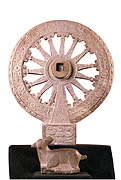| |
| ◎
Buddhist Rituals and Observances│1│2│3│4│ |
|
|
Ruins of a stupa
containing the Buddha's relics |
C.
Buddhist Iconography — the
Lotus, the 卍 Symbol, the Dharma Wheel and the Buddhist Flag
Buddhist imageries, representing the teachings of the Buddha, are often
found carved on the walls of different Buddhist architectures, including
the temple and the pagoda. The lotus,
for example, symbolizes not only purity and openness, but also the state
of enlightenment. Moreover, the Buddha's disciples—monastics and laity
alike—were often depicted as sitting atop of the lotus to show the purity
of their cultivation and the undefiled state of their minds.
卍
or “srivatsalaksana” is
a traditional Indian symbol of auspiciousness, which often appears on
the palms of the Buddha, the soles of his feet or his chest in Buddhist
art. It is used to symbolize the Buddha nature that is inherent in the
minds of every sentient being and the Buddhas as well.
“The
Dharma Wheel” symbolizes the Buddha's teachings. When
it is set in motion, it represents the spread of the Dharma as the sounds
of the teaching reach every corner of every realm.
“The
Buddhist Flag” has
five colored vertical stripes and five colored horizontal stripes, representing
the various aspects of the Buddha's teachings. While the vertical stripes
are used to symbolize the unceasing nature of the Dharma, the five colors
are chosen for their symbolic meanings:
· Blue: represents the undefiled mind and
inner strength in seeking the Dharma from the Buddha, symbolizing the
root of mindfulness and wisdom
· Yellow: represents a mind that is like
the radiance of the Buddha's loving-kindness and compassion, symbolizing
the diamond-like wisdom.
· Red: represents the diligent and unrelenting
practices of the Buddha's teachings, symbolizing loving-kindness, compassion,
and the one-pointed concentration of the mind in cultivation.
· White: represents the eradication of afflictions
and oppression with a pure, undefiled mind, symbolizing wisdom of purity.
· Orange: represents tolerance for all kinds
of humiliation and the safeguard against digression from the right path
in life, symbolizing the wisdom of magnanimity.
Who officially designated
the Buddhist flag? It was officially accepted as the International Buddhist
Flag by the 1954 “World Buddhist Congress” in Sri Lanka, and has since
been used uniformly in every Buddhist country.
Therefore, when we see depictions of people paying homage to the stupa,
the Buddha's footprints, the bodhi tree or the diamond throne on Buddhist
architecture and ancient artifacts, they are engaging in the auspicious
act of faith and devotion by paying homage to the Buddha himself.

|
|
Stone Dharma Wheel /
Bangkok National Museum Collection, Thailand |
The Buddhist
flag |
|
|











